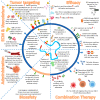Oncolytic Virotherapy in Solid Tumors: The Challenges and Achievements
- PMID: 33546172
- PMCID: PMC7913179
- DOI: 10.3390/cancers13040588
Oncolytic Virotherapy in Solid Tumors: The Challenges and Achievements
Abstract
Oncolytic virotherapy (OVT) is a promising approach in cancer immunotherapy. Oncolytic viruses (OVs) could be applied in cancer immunotherapy without in-depth knowledge of tumor antigens. The capability of genetic modification makes OVs exciting therapeutic tools with a high potential for manipulation. Improving efficacy, employing immunostimulatory elements, changing the immunosuppressive tumor microenvironment (TME) to inflammatory TME, optimizing their delivery system, and increasing the safety are the main areas of OVs manipulations. Recently, the reciprocal interaction of OVs and TME has become a hot topic for investigators to enhance the efficacy of OVT with less off-target adverse events. Current investigations suggest that the main application of OVT is to provoke the antitumor immune response in the TME, which synergize the effects of other immunotherapies such as immune-checkpoint blockers and adoptive cell therapy. In this review, we focused on the effects of OVs on the TME and antitumor immune responses. Furthermore, OVT challenges, including its moderate efficiency, safety concerns, and delivery strategies, along with recent achievements to overcome challenges, are thoroughly discussed.
Keywords: antitumor immune response; delivery; genetic modification; oncolytic virus; tumor microenvironment.
Conflict of interest statement
The authors declare no conflict of interest.
Figures

Similar articles
-
Development of oncolytic virotherapy: from genetic modification to combination therapy.Front Med. 2020 Apr;14(2):160-184. doi: 10.1007/s11684-020-0750-4. Epub 2020 Mar 7. Front Med. 2020. PMID: 32146606 Free PMC article. Review.
-
Oncolytic virotherapy evolved into the fourth generation as tumor immunotherapy.J Transl Med. 2023 Jul 25;21(1):500. doi: 10.1186/s12967-023-04360-8. J Transl Med. 2023. PMID: 37491263 Free PMC article. Review.
-
Oncolytic virotherapy reverses the immunosuppressive tumor microenvironment and its potential in combination with immunotherapy.Cancer Cell Int. 2021 May 13;21(1):262. doi: 10.1186/s12935-021-01972-2. Cancer Cell Int. 2021. PMID: 33985527 Free PMC article. Review.
-
Improving systemic delivery of oncolytic virus by cellular carriers.Cancer Biol Med. 2025 Jan 17;21(12):1104-19. doi: 10.20892/j.issn.2095-3941.2024.0390. Cancer Biol Med. 2025. PMID: 39831754 Free PMC article. Review.
-
Remodeling the tumor microenvironment by oncolytic viruses: beyond oncolysis of tumor cells for cancer treatment.J Immunother Cancer. 2022 May;10(5):e004167. doi: 10.1136/jitc-2021-004167. J Immunother Cancer. 2022. PMID: 35640930 Free PMC article. Review.
Cited by
-
Current and future immunotherapeutic approaches in pancreatic cancer treatment.J Hematol Oncol. 2024 Jun 4;17(1):40. doi: 10.1186/s13045-024-01561-6. J Hematol Oncol. 2024. PMID: 38835055 Free PMC article. Review.
-
The Future of Interventions for Stage IV Colorectal Cancers.Clin Colon Rectal Surg. 2023 Feb 7;37(2):114-121. doi: 10.1055/s-0043-1761624. eCollection 2024 Mar. Clin Colon Rectal Surg. 2023. PMID: 38327731 Free PMC article. Review.
-
Viral-Porphyrin Combo: Photodynamic and Oncolytic Viral Therapy for Potent Glioblastoma Treatment.Int J Mol Sci. 2024 Nov 22;25(23):12578. doi: 10.3390/ijms252312578. Int J Mol Sci. 2024. PMID: 39684289 Free PMC article.
-
Oncolytic virus-based suicide gene therapy for cancer treatment: a perspective of the clinical trials conducted at Henry Ford Health.Transl Med Commun. 2023;8(1):11. doi: 10.1186/s41231-023-00144-w. Epub 2023 Apr 10. Transl Med Commun. 2023. PMID: 37065938 Free PMC article. Review.
-
CAR-T cell combination therapy: the next revolution in cancer treatment.Cancer Cell Int. 2022 Nov 24;22(1):365. doi: 10.1186/s12935-022-02778-6. Cancer Cell Int. 2022. PMID: 36419058 Free PMC article. Review.
References
-
- Dock G. The influence of complicating diseases upon leukaemia. Am. J. Med. Sci. (1827–1924) 1904;127:563. doi: 10.1097/00000441-190412740-00001. - DOI
-
- Annels N.E., Mansfield D., Arif M., Ballesteros-Merino C., Simpson G.R., Denyer M., Sandhu S.S., Melcher A.A., Harrington K.J., Davies B. Phase I trial of an ICAM-1-targeted immunotherapeutic-coxsackievirus A21 (CVA21) as an oncolytic agent against non muscle-invasive bladder cancer. Clin. Cancer Res. 2019;25:5818–5831. doi: 10.1158/1078-0432.CCR-18-4022. - DOI - PubMed
Publication types
LinkOut - more resources
Full Text Sources
Other Literature Sources

